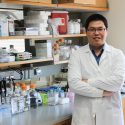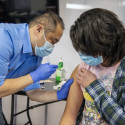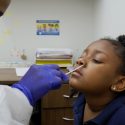Wisconsin State Laboratory of Hygiene, partner labs serve state during pandemic
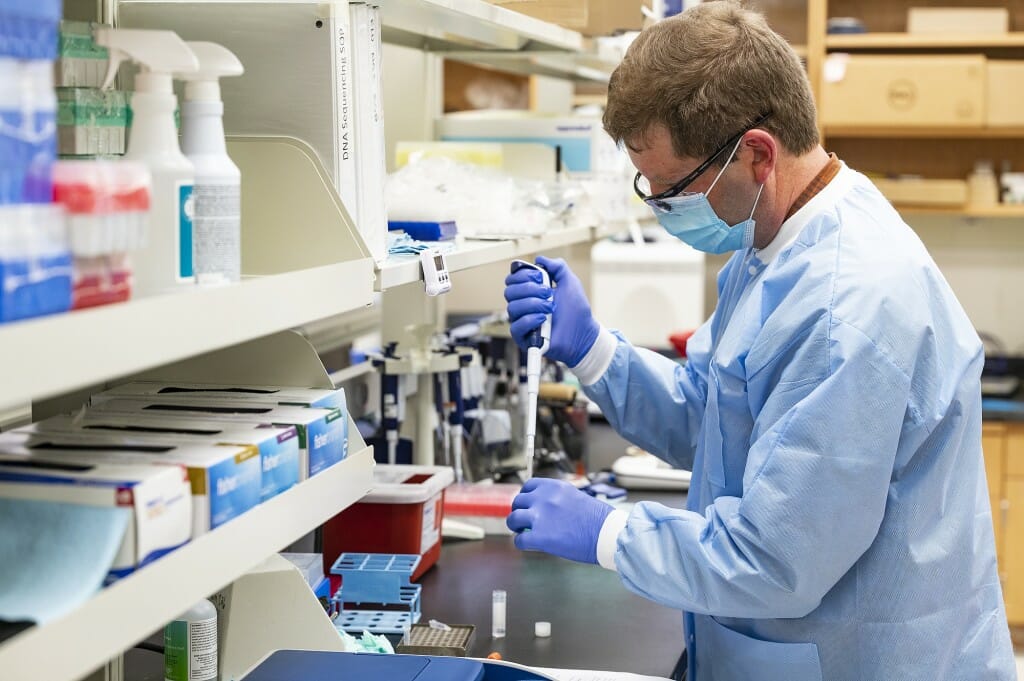
Tim Davis, microbiologist at the Wisconsin State Laboratory of Hygiene at UW–Madison, uses a pipette as he works on COVID-19 genomic sequencing. Photo: Bryce Richter
From February through June, we will highlight the ways that UW–Madison powers the state’s economy through research and innovation, educates the next generation and reaches out to Wisconsinites to improve their lives. March’s theme is Health. Watch for more at #CantStopABadger and #UWimpact on social media. Your support can help us continue this work.
When the COVID-19 pandemic suddenly struck in early 2020, the University of Wisconsin–Madison Wisconsin State Laboratory of Hygiene had to quickly develop ways to provide ample testing for the SARS-CoV-2 virus that causes the disease.
“The demand for testing within the first couple of weeks in March 2020 was unprecedented and way beyond our capacity and that of the City of Milwaukee Health Department laboratory, which was the only other lab testing (for SARS-CoV-2) in the state at the time,” says Alana Sterkel, assistant director of the WSLH Communicable Disease Division. “We couldn’t do millions of tests.”
However, WSLH coordinates the Wisconsin Clinical Lab Network, with more than 130 hospital and clinical labs across the state, and was able to quickly pull together collaborations to increase COVID-19 testing capacity.
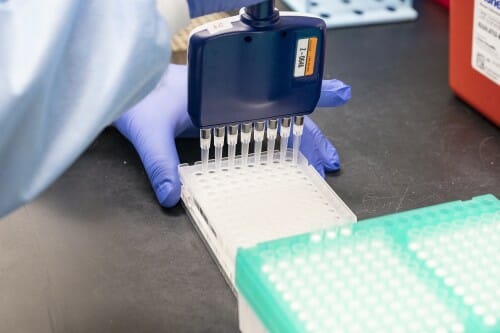
A multichannel pipette helps with COVID-19 genomic sequencing. Photo: Bryce Richter
“Only by partnering with WCLN and supporting them could we meet the need,” Sterkel says.
As test kits became commercially available, WSLH helped more than 100 network member labs begin to do their own testing. The partnership has since provided robust public health data.
Infectious disease surveillance
The state’s clinical lab network has its roots in infectious disease surveillance. In 1995, WSLH and nine clinical laboratories formed an influenza surveillance network to help public health experts understand which influenza virus strains are circulating in a given year. . It was one of the first lab-based surveillance networks in the country. The network helped WSLH obtain specimens for testing and informed public health about the flu strains in circulation.
In response to directives from the Centers for Disease Control and Prevention’s Laboratory Response Network, the network evolved into the WCLN and remains a model for public health labs across the U.S.
Now, partner labs in Wisconsin share specimens, data, and knowledge about SARS-CoV-2; influenza and other respiratory pathogens, gastrointestinal pathogens; and antibiotic resistant organisms.
A laboratory technical advisory group, formed in 2004, offers labs in the network clinical laboratory expertise and educational programming, including about eight webinars a year. A network listserv provides members a quick way to communicate, share questions, and request support.
During the pandemic, the listserv has served as a way for individuals in the network to ask questions and get answers in real time, and ensure every lab in the network receives the same information at once.
A Central Hub for COVID-19 Information, Guidance, and Testing
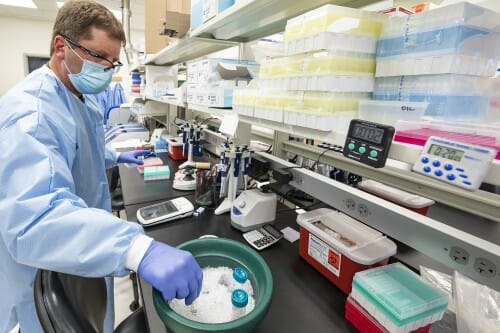
Davis places a sample in ice as he works on COVID-19 genomic sequencing. Photo: Bryce Richter
As Wisconsin’s state public health laboratory and one of the first to test for SARS-CoV-2 in Wisconsin, WSLH is a central hub for other laboratories to find COVID-19 information, guidance, and SARS-CoV-2 testing resources in Wisconsin.
The state lab’s COVID-19 web page shares technical resources, links to U.S. Food and Drug Administration information, , and biosafety guidance for safe testing within clinical labs. During the early months of the pandemic, WSLH offered COVID-19 webinars, often weekly, to the WCLN.
“It was great because we could immediately reach out, provide up-to-date info as of that moment, and answer questions in real time about what tests had gotten FDA authorization, what reagents were in short supply, and other limitations,” says Sterkel.
When commercial COVID-19 tests became available, the WSLH provided guidance and validation panels to help clinical laboratories perform their own testing This allowed for faster testing closer to patients and swiftly ramped up the state’s testing capacity.
Wisconsin Governor Tony Evers applauded the ability of the WCLN to rapidly expand COVID-19 testing capacity in the early weeks of the pandemic, when the number of labs testing for the SARS-CoV-2 virus grew from eight to 36.
“Wisconsin’s capacity for COVID-19 testing is thanks to hard work from each individual clinical lab, all working together in a combined effort,” says Sterkel. “It has been a privilege and a pleasure to work with all of these clinical labs.”
Empowering labs across Wisconsin
As a network of labs, WCLN’s efforts have helped ensure labs throughout the state maintain the supplies they need to conduct COVID-19 testing. This was especially true early on in the pandemic, when supply chains were squeezed.
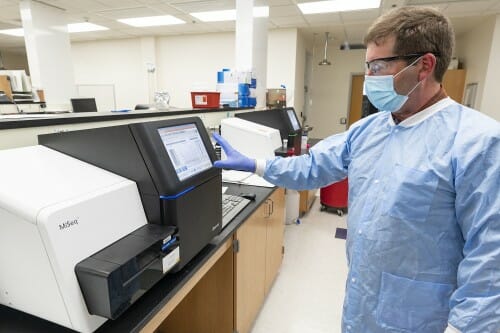
Davis works with a MiSeq sequencer. Photo: Bryce Richter
“Just like toilet paper was flying off the shelves, so were reagents,” said Sterkel. “We were able to trade with labs who had more plastics than liquids, or more liquids than plastics.”
Working with the Wisconsin Department of Health Services , WSLH also surveyed labs to gain a better sense of the state’s capacity for COVID testing, which allowed them to request needed supplies and share data with the network.
“We could give information back to them and collect information important for the state’s public health response,” says Sterkel. “We recognized the shortages they were experiencing and advocated for additional supplies to come to Wisconsin. Governor Evers wrote letters to manufacturers to express our interest in getting more supplies.”
Sterkel worked with DHS as a technical subject matter expert on lab testing and was able to coordinate an influx of collection kits from Federal Emergency Management Agency and DHS for the state’s network of labs.
Erin Bowles, the WCLN coordinator for the state lab’s communicable disease division, worked with the WSLH’s contracted courier service to set up daily pick-up service, making it easy for WCLN labs to quickly send specimens to the WSLH.
“That was a huge asset for more remote areas,” says Sterkel.
“With these partnerships, the labs don’t feel isolated,” Bowles adds. “They see the integral role they play by getting us surveillance samples or data. They feel proud of the work they’ve done. We haven’t just tried to take testing and keep it in-house. They do the testing and keep it close to the patient.”
WCLN labs have been asked to submit total numbers of positive and negative tests for public health surveillance purposes. Some also have been asked to send in residual positive samples to be sequenced by the state hygiene lab to monitor for variants of concern.
“Sequencing is a highly complex lab method that’s not widely available,” says Sterkel. “We can leverage the WCLN to get additional samples to enhance surveillance for variants.”
Contributing to public health
Sterkel says the WCLN has remained true to its intended purpose: gathering surveillance information on infectious diseases for public health and providing a rapid communication resource for labs around the state.
“We intend to continue this communication, education, and surveillance moving forward, to help us continue to respond to the COVID-19 pandemic,” says Sterkel. “Thanks to the WCLN, we will be ready for the next emerging pathogen. We are poised to be nimble.”
UW-Madison contributes $20.8 billion per year to the Wisconsin economy, and UW–Madison related start-ups contribute an additional $10 billion. Read more here.
Subscribe to Wisconsin Ideas
Want more stories of the Wisconsin Idea in action? Sign-up for our monthly e-newsletter highlighting how Badgers are taking their education and research beyond the boundaries of the classroom to improve lives.

